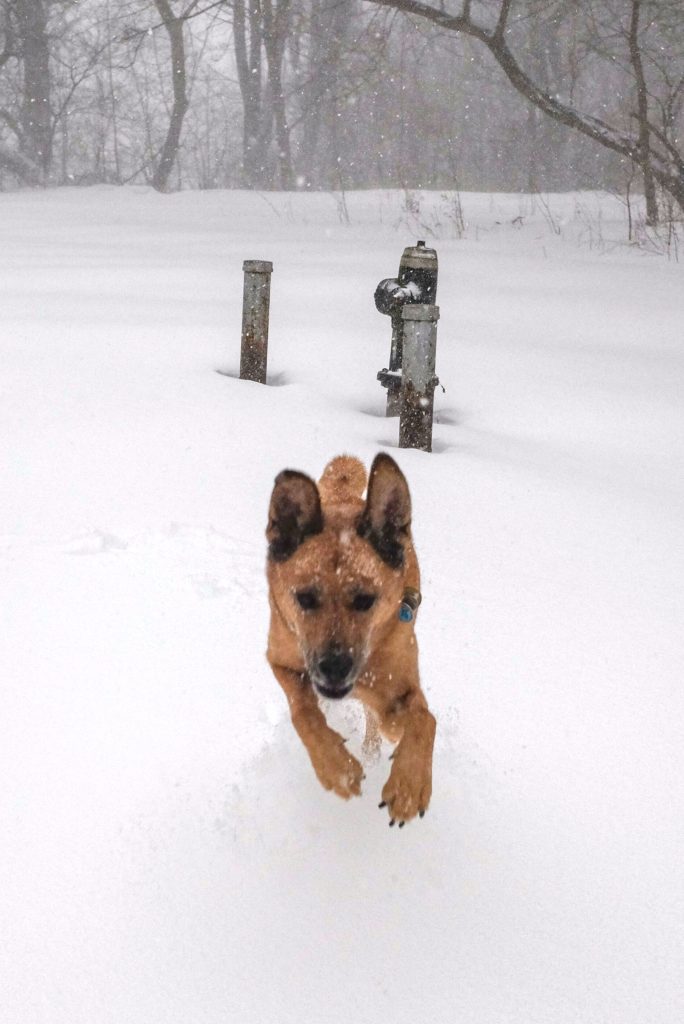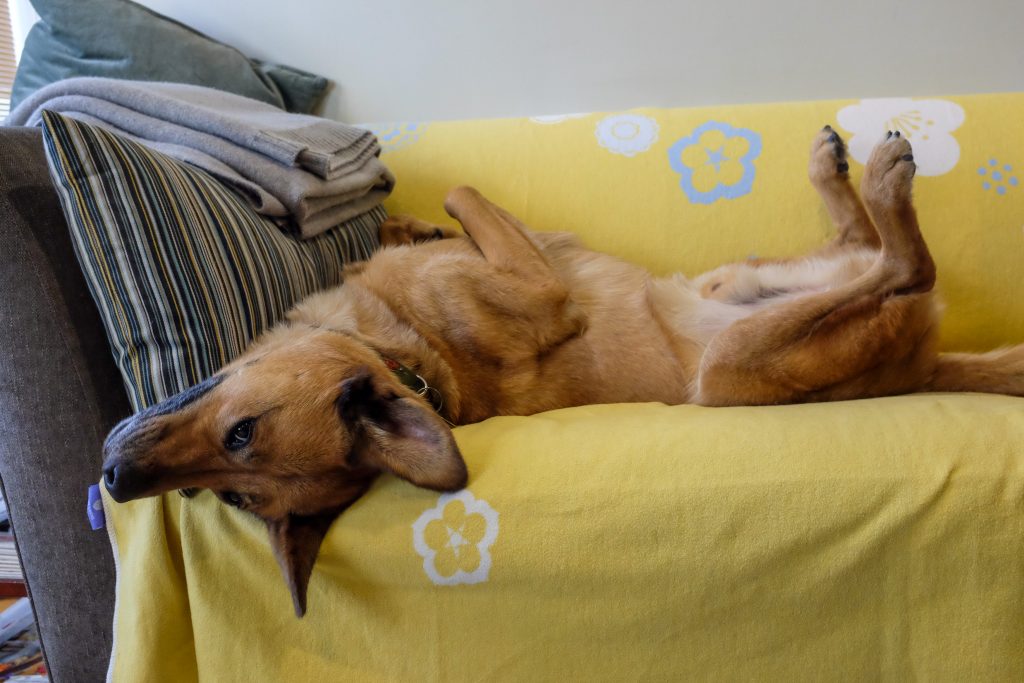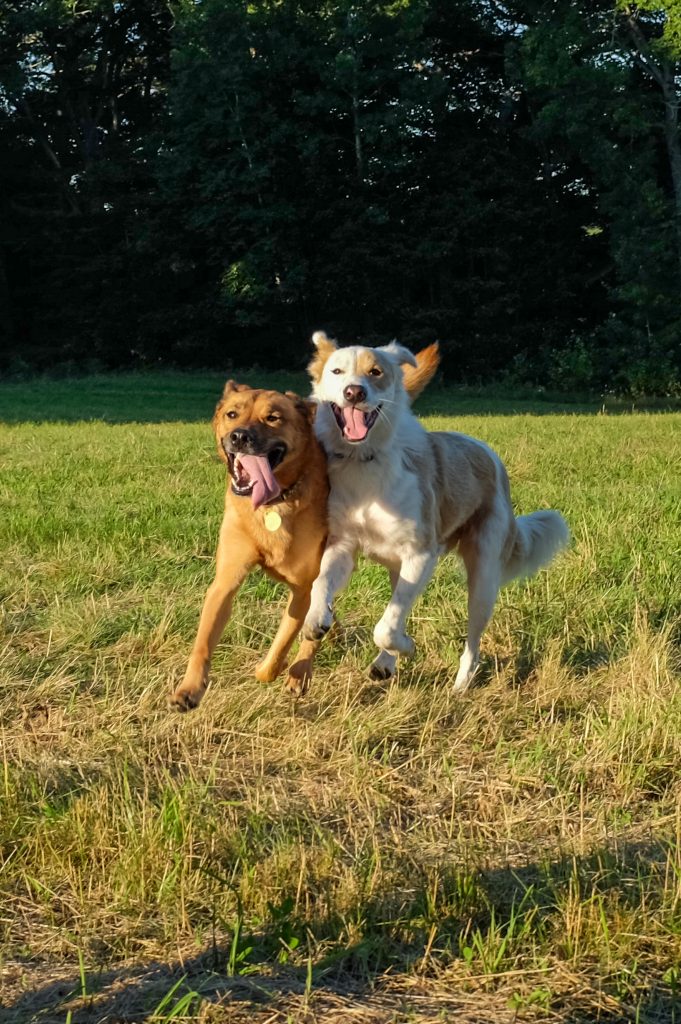From a journal entry, dated 11 March 2008:
On Friday morning, Peter and I threw productivity to the winds and drove out to North Shore Animal League to find a puppy. We had to walk through an arcade of older, problem dogs to reach the puppies, who, when we found them, seemed groggy and amiable. Peter was taken with a couple of the black lab mixes, though we had intended not to adopt a dog similar to Lota [our previous dog], and I by a sharpei mix with a sweet disposition and a dark, absurdist collage of a face. Then I spotted, in the kitten room, a golden puppy with a brown muzzle, who was quarantined there because he was recovering from parvo. The name on his cage was Frost, and he was purportedly a 10-week-old shepherd mix. The volunteers caged the cats in the room so we could let him run loose, which he did, sloppy-leggedly. He had high spirits; he was a little saucy; he warmed up to us quickly. I think we fell for him because he seemed to have more personality than the dogs in the other room, but after we filled out the application, and while we waited on a bench for them to call our references, I began to worry that maybe he was too alpha, too independent, wouldn’t listen to us, wouldn’t bond with us. I went back into his room to visit with him, and he turned and wagged his tail as if he recognized me, so I was reassured. I had to repeat the encounter a few times to calm myself before our application was approved.
We parked at a nearby Whole Foods, so Peter could buy us some lunch, and while Toby and I were waiting—Toby was the boy’s name we’d picked out, Daisy the girl’s—one of the grocery staffers, an overweight man in a uniform, paused in his collection of stray metal carts to ask me to roll down the window so he could pet Toby. “He’s a heartbreaker,” he said. This, it turns out, is what everyone says upon meeting Toby.
I mean, look at him:
“This one seems so alert,” became a joke between Peter and me for years afterward. A few days after we brought him home, Toby swallowed a chunk of mortar in our downstairs neighbor’s backyard, which an X-ray at the vet was unable to locate. He ate the upper of one of Peter’s boots. Once he ate a Shakespeare play that I had been reading. The first night, we tried making him sleep in a crate in the kitchen, which ended with me in the crate beside him, consoling him from three to four-thirty. He wanted too badly to be near us. We tethered him to a bedpost the next night, and he slept curled up on the floor beside me from then on. To this day, the bedpost has his toothmarks on it.
“What if we got the wrong dog?” became another household joke. Because of course he was the wrong dog, especially for me. What was a pensive, finicky, melancholic middle-aged homosexual doing with a brash, sunny puppy who liked nothing so much as swaggering up to ladies? Which was also, of course, why he was so great for us. I used to joke that Lota, our previous dog, had been like the quiet girl who sits in the back of the classroom wearing all black and writing poetry in her notebook, and that Toby was the captain of the football team—a bruiser. Affable, athletic, and blond. With a heart of gold.
He was the fastest animal I was ever friends with. I used to think, as I watched him swoop in wide, easy circles around me in the park, that it must be from watching animals move that the idea of superpowers came to the writers of comic books. When I threw his favorite toy for him, a squeaky plastic squiggle with a knotted rope tail, he and the toy reached the spot where it was going to land at the same time. Once he grew into himself, he was all legs, and he always made a point of greeting greyhounds, which made me wonder if he had greyhound in him. People asked if he was a Carolina dog, which according to myth (but not, alas, genetic analysis) is the only surviving aboriginal dog breed in North America. His coloring matched the breed, as did his personality: restless, fast, an aptitude for pursuit. When he was young, I let him chase squirrels, until one day he overtook one. He lay on top of it for a moment, looking at it, puzzled, not sure what to do next. I called Toby, and the squirrel got away. That was the last one I let him chase.
Little Toughie was one of our nicknames for him his first year, because he walked like a palooka and for months he seemed to accept room, board, and toys from us without feeling obliged to grant us any special recognition in return, or even much eye contact. That changed abruptly after we boarded him at a free-run kennel upstate while on a trip. We got him back covered in bite wounds. From then on, whenever we came home, he wanted to kiss our ears and jump up on the couch beside us and snuggle. Peter came to call this “couch time.” (We never boarded him at a kennel again.)
The morning after Obama’s victory, he woke us up at 7am, agitated. Did he have to relieve himself? Before we could get him downstairs—before I could even get pants and shoes on—he started barking at the top of his lungs—screaming, really—and twisting in circles, spraying pee and poop as he turned. Vets pressured us to spend thousands of dollars on an MRI and a cerebrospinal fluid tap, to rule out a couple of very rare conditions—brain tumors and malformed blood vessels in the brain—that would have been almost impossible to do anything about. Once these were ruled out, we did the much less expensive thing we should have done in the first place: start him on epilepsy medications, trying different doses and medications until we found a combination that worked.
That took more than a year. We learned his early-warning sign: looking around nervously at, and snapping at, flies that weren’t actually in the room. (Really existing flies also made him anxious, I think because he associated them with the anxiety that accompanied the imaginary ones.) Twice he had a seizure while off leash in Prospect Park, and before I could grab his collar, as soon as he stopped twirling, he bolted—out of the park. I chuffed behind as in a dream where you’re running as fast as you can but don’t seem to be going anywhere. He crossed two busy roads alone, at top speed. By the time I got to our stoop, Peter, who had heard him howling downstairs, was letting him in. For more than a year after the second seizure in the park, all his walks were on leash. He was still able to run a little thanks to a really long training leash, and I brought a tennis ball that he jumped for when I tossed it, as we walked. I never measured, but he seemed to be able to jump higher than six feet with ease. Because he was restricted to the leash, he missed most of the developmental window for play with other dogs. In his whole life, there were only a handful of dogs he felt comfortable enough to play with.
His focus, instead, was on people. One of his favorites was Jimmy, a retired cook who sometimes worked as a security guard at Yankee Stadium. Jimmy watched the women’s softball games for years from a bench in the corner of Prospect Park’s ballfields, with his own dog and a few friends, and Toby always insisted on stopping to visit with them. A nurse who saw us from afar while walking her and her wife’s dog came up one day to confess she had a crush on Toby. Among his earliest friends were a dancer, his husband in finance, and their son, who must have been in preschool when we met and is finishing high school now. The boy changed so much over the years that I sometimes had trouble recognizing him but Toby never did. In his last years a woman who owned two chihuahuas used to give him homemade sweet-potato-and-flaxseed treats. I can’t list all Toby’s friends, because there were just too many. It sometimes felt as though Toby were a celebrity, and Peter and I were his entourage. Which is making a joke of it: it also felt as though Toby was a gift that we were giving to everyone we met, because when we walked through the park with him, it felt like we were distributing happiness. He literally smiled. “He’s smiling at me,” people often said aloud, as if they found it hard to believe. They also often said, “Those ears.” He was especially gentle with children. He would let them do anything. The only concern I ever had was that he would waggle his enormous tail so hard that he would inadvertently topple one over (which never happened). I would tell him to lie down, and he would let them rub his belly. Usually he gave them a kiss on the face or hands.
You shouldn’t think he was an angel, however. When young, he stole other dogs’ toys. I once had to pay a miffed owner five dollars, because he wouldn’t come back with it and the owner wanted to go home. Another time, he trotted into the dog pond with a stolen toy, only to release it once he got in over his head. (He was so afraid of getting in over his head that it wasn’t until he was eleven that he almost accidentally discovered he could swim. If I went swimming, he would race back and forth on shore, yipping short, sharp barks of terror and concern.) As the toy floated away, helplessly, I rolled up my pants and walked in after it. Rats swim in that pond, by the way; I’ve seen them. Toby disliked male dogs that hadn’t been fixed and dogs with very big hair and would try to scrap with them. The fights were mostly display—he never bit another dog—but he did topple and wrestle to the ground a few, which was rattling. I came to think of him as a dangerous weapon, which I had to treat with the appropriate respect. We trained for years. In his prime he knew sit, down, stay, come, leave it, drop it, heel, and fetch. I was so proud of him. Once we found the right dosage, he walked by my side through the park off leash almost every morning.
I can’t write down everything. Peter reminds me that when we watched the third season of Twin Peaks, which Toby found a little scary, he would come over to the couch, stick his snout under the blanket covering us, and, when we lifted the blanket, climb up and sleep under the blanket, between us. When he was still very young, it was his habit, whenever I took him running with me, to pick up the largest stick he could find, practically a log, and carry it balanced in his mouth all the way around the park. It was steadying for him, like a security blanket. I used to think that when we got home, I should tweet, “I’m the guy you just saw running around the park with a dog carrying a stick as big as the dog.”
In July 2018, he tumbled while running after a toy and cried, unable to get up. I carried him home, almost a mile. A frankly incompetent vet insisted that one of his hip bones had come out of its socket, even though she took two X-rays that showed the hip bone in place. A day and a thousand dollars later, a vet at a second clinic advised that his hip was fine, but that his gait was “ataxic,” that is, uncoordinated, probably, in her opinion, because he had canine degenerative myelopathy, a progressive form of paralysis, similar to ALS in humans, that begins with the extremities and is not only incurable but untreatable. After diagnosis, time to death is typically between six months and three years. It is a cruel disease, because the dogs remain very much themselves, and in Toby’s case, in cheerful spirits, even as they lose sensation in, and command over, their bodies.
We supported his back legs with a sling for several months, and the sprained muscles in his back legs healed almost completely. He wobbled, but he was able to walk on his own again. After a while he stopped being able to raise his tail, however, and some time after that, he stopped being able to wag it. He started to drag his back paws, which we protected with Pawz rubber booties, which are ordinarily used to protect dogs’ paws from the salt that’s put down to de-ice roads in winter. In late spring 2020, we began to support his walking with a Help-‘Em-Up harness. Sometimes we were able to take it off, though, and get by without it. His bark started to become higher in pitch. He started having accidents in the house, which we minimized by doing some arithmetic and, after some experimentation, setting up a new schedule for mealtimes and walk times, which we had to keep to rigidly, and even then didn’t always work. A blood test in September 2020 showed anomalies, suggestive of something new wrong inside, that we decided it didn’t make sense to investigate. In December 2020, the owner of Slope Cellars, a wine store in Park Slope, recognized Toby’s gait as characteristic of the illness and hailed Peter and offered to donate a Walkin’ Wheels dog wheelchair that a dog of hers with the same illness had used. He tore around our apartment with it as soon as we rigged him into it, and until his last day he went on two long walks in the park with it every day. Almost all the bird and nature photos on this blog were taken in his company. About a week ago he became sick, in a way that didn’t respond to the usual home and over-the-counter remedies but only got worse, and after a lot of agony, we decided it was time. After his last walk in the park, on Wednesday afternoon, while I was waiting on the sidewalk with Toby for Peter to pick us up in our car, a dozen schoolchildren came up and asked to pet him, and he licked their fingers while they stroked his head and told me about the dogs and cats they knew and had known. “I like that dog,” one of the little girls said, in a tone of voice suggesting that not all dogs met her standards.







